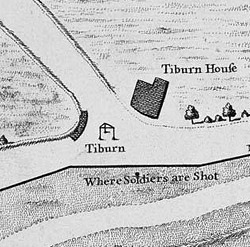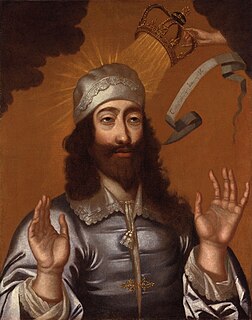Related Research Articles

Tyburn was a manor (estate) in the county of Middlesex, one of two which were served by the parish of Marylebone.

The Restoration of the Stuart monarchy in the kingdoms of England, Scotland and Ireland took place in 1660 when King Charles II returned from exile in continental Europe. The preceding period of the Protectorate and the civil wars came to be known as the Interregnum (1649–1660).

Hanging is the suspension of a person by a noose or ligature around the neck. The Oxford English Dictionary states that hanging in this sense is "specifically to put to death by suspension by the neck", though it formerly also referred to crucifixion and death by impalement in which the body would remain "hanging". Hanging has been a common method of capital punishment since medieval times, and is the primary execution method in numerous countries and regions. The first known account of execution by hanging was in Homer's Odyssey. In this specialised meaning of the common word hang, the past and past participle is hanged instead of hung.
Regicide is the purposeful killing of a monarch or sovereign of a polity and is often associated with the usurpation of power. A regicide can also be the person responsible for the killing. The word comes from the Latin roots of regis and cida (cidium), meaning "of monarch" and "killer" respectively.

James Scott, 1st Duke of Monmouth, 1st Duke of Buccleuch, KG, PC was a Dutch-born English nobleman and military officer. Originally called James Crofts or James Fitzroy, he was born in Rotterdam in the Netherlands, the eldest illegitimate son of Charles II of England, Scotland, and Ireland with his mistress Lucy Walter.

Albert Pierrepoint was an English hangman who executed between 435 and 600 people in a 25-year career that ended in 1956. His father Henry and uncle Thomas were official hangmen before him.

William Marwood was a hangman for the British government. He developed the technique of hanging known as the "long drop".

Richard Brandon was the common executioner of London from 1639 to 1649, who inherited his role from his father Gregory Brandon and was sometimes known as Young Gregory. Richard Brandon is often named as the executioner of Charles I, though the executioner's identity is not definitely known.

John Ketch, generally known as Jack Ketch, was an infamous English executioner employed by King Charles II. He became famous through the way he performed his duties during the tumults of the 1680s, when he was often mentioned in broadsheet accounts that circulated throughout the Kingdom of England. He is thought to have been appointed in 1663. He executed the death sentences against William Russell, Lord Russell, in Lincoln's Inn Fields on 21 July 1683, and James Scott, 1st Duke of Monmouth, on 15 July 1685, after the Monmouth Rebellion. Ketch's notoriety stems from "barbarity at the execution of Lord Russell, the Duke of Monmouth, and other political offenders".

The execution of Charles I by beheading occurred on Tuesday 30 January 1649 outside the Banqueting House on Whitehall. The execution was the culmination of political and military conflicts between the royalists and the parliamentarians in England during the English Civil War, leading to the capture and trial of Charles I. On Saturday 27 January 1649, the parliamentarian High Court of Justice had declared Charles guilty of attempting to "uphold in himself an unlimited and tyrannical power to rule according to his will, and to overthrow the rights and liberties of the people" and he was sentenced to death.
Paskah Rose, also known as Pascha Rose, was an English executioner briefly during 1686, successor to Jack Ketch.

Lisle's Tennis Court was a building off Portugal Street in Lincoln's Inn Fields in London. Originally built as a real tennis court, it was used as a playhouse during two periods, 1661–1674 and 1695–1705. During the early period, the theatre was called Lincoln's Inn Fields Playhouse, also known as The Duke's Playhouse, The New Theatre or The Opera. The building was demolished and replaced by a purpose-built theatre for a third period, 1714–1728. The tennis court theatre was the first public playhouse in London to feature the moveable scenery that would become a standard feature of Restoration theatres.
Sir John Temple was an Irish politician, Speaker of the Irish House of Commons and Attorney General for Ireland. He was the great-great-grandfather of the distinguished statesman Henry John Temple, 3rd Viscount Palmerston. His descendants in the female line include the famous poet Lord Byron.
Jemmy Botting was an English executioner who was the hangman at Newgate Prison in London, from 1817 to 1819 during which tenure he claimed to have hanged a total of 175 persons. He was succeeded by John Foxton who was his assistant from 1818.

King Charles the Martyr, or Charles, King and Martyr, is a title of Charles I, who was King of England, Scotland and Ireland from 1625 until his execution on 30 January 1649. The title is used by high church Anglicans who regard Charles's execution as a martyrdom. His feast day in the Anglican calendar of saints is 30 January, the anniversary of his execution in 1649. The cult of Charles the Martyr was historically popular with Tories. The observance was one of several "state services" removed in 1859 from the Book of Common Prayer of the Church of England and the Church of Ireland. There remain some churches and parishes dedicated to Charles the Martyr, and his cult is maintained by some Anglo-Catholic societies, including the Society of King Charles the Martyr founded in 1894 and the Royal Martyr Church Union founded in 1906.

Titus Defoe is a comics character in an eponymous story published in the British science fiction anthology 2000 AD. He was created by writer Pat Mills and artist Leigh Gallagher and first appeared in prog 1540, cover date 6 June 2007.
Hugh Montgomery, 1st Earl of Mount Alexander, known as The Viscount Montgomery from 1642 to 1661, was an Irish peer. He was appointed to command his father's regiment, 1642. He was commander-in-chief of the Royalist army in Ulster in 1649 and seized successively Belfast, Antrim, and Carrickfergus. He surrendered to Oliver Cromwell, and was banished to Holland. At the Restoration in 1660 he was appointed life master of ordnance in Ireland and one year later created Earl of Mount Alexander.

Abraham Reynardson was an English merchant who was Lord Mayor of London in 1649.
Sir Charles Hussey was an English politician who sat in the House of Commons in two periods between 1656 and 1664.
Sir Abraham Cullen, 1st Baronet (c.1624-1668), of East Sheen Surrey, was an English merchant and politician who sat in the House of Commons from 1661 to 1668.
References
- ↑ (1832). The Trials of Charles the First, and of Some of the Regicides. London: John Murray. p. 112.
- ↑ "The Courier". Calcutta Gazette. 9 August 1787. p. 5.
- 1 2 Abbott, Geoffrey (2012). Execution: A Guide to the Ultimate Penalty. Chichester: Summersdale Publishers. p. 243.
- ↑ Mannix, Daniel P. (1986). The History of Torture. Dorset Press. p. 103.